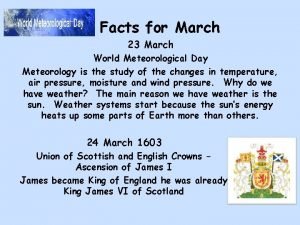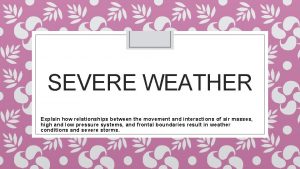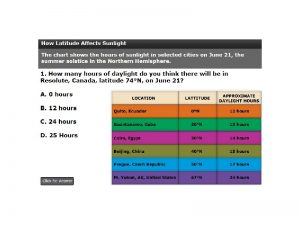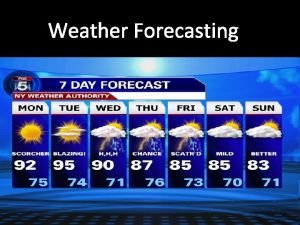Intro to Weather March 23 Explain how relationships


















- Slides: 18

Intro to Weather March 23 Explain how relationships between the movement and interactions of air masses, high and low pressure systems, and frontal boundaries result in weather conditions and severe storms.

Think about it The climate of an area is fairly constant (at least before global warming). But weather changes a lot, beyond seasonal changes caused by orbiting the sun. Weather often changes from one day to another. What causes the differences in weather that occur within a week?

Weather Basics Weather is different from climate because weather is the short-term state of the atmosphere. Weather, unlike climate, can be very different from year to year. Weather includes temperature, precipitation, air pressure, humidity, wind and visibility. Weather can be predicted over short periods, but not perfectly.

Air Pressure and Temperature We have already learned that temperature and air pressure are related. High temperature causes air to rise because the air particles spread out, making air less dense. Low temperature causes air to sink because the air particles cram closer together, making it more dense. At Earth’s surface, a place with high pressure has denser air particles than a place with low air pressure. To reach equilibrium, wind moves air from high pressure to low pressure.

Atmospheric Pressure and Altitude Air is made of tiny molecules, which means air has mass. Even though you don’t feel it, you are “carrying” air all the time. This is what we mean by air pressure. There is more air pressure at Earth’s surface than at higher altitudes. This is shown in the figure. At Earth’s surface, there are molecules that you are “carrying”, so the air pressure is higher. At a higher altitude, you are not “carrying” as many air molecules, so the air pressure is lower. Lower atmospheric pressure Higher atmospheric pressure

Atmospheric Pressure and Altitude Air is less dense (particles spread apart) at higher altitudes. Lower atmospheric pressure Air is more dense (particles closer together) at lower altitudes. Atmospheric pressure can be measured in different units, including k. Pa, as shown in this figure. Higher atmospheric pressure

Atmospheric Pressure and Weather Maps The local air pressure at Earth’s surface is shown on a weather map. Areas of high pressure are marked with an H. Areas of low pressure are marked with an L. Numbered lines called isobars are drawn to show areas with the same pressure. You can tell how air pressure changes by looking at the map.

Atmospheric Pressure and Weather Maps Air always moves from high pressure to low pressure. The high pressure areas have a blue H, and the low pressure areas have a red L.

Atmospheric Pressure and Weather A high pressure area indicates a place where cool, dense air is sinking. The air is dry, and it warms as it sinks, leading to warm weather. A low pressure area indicates a place where warm, less dense air is rising. The air is moist, and it cools as it rises, leading to cloud formation and precipitation.

Air masses and Weather Fronts An Air mass is a large volume of air that has almost equal temperature and amount of moisture in it. (The air in the whole area is about the same. ) Air masses form when the air over a large area of Earth stays in place for several days. This allows the air to adjust to the temperature and humidity of the land or water beneath it. When an air mass moves, it causes changes to the weather in the new area it travels to.

Air Masses and Weather Fronts When different air masses meet, they form a front. A front is the boundary between the two air masses, and it is the result of the different densities of the air. Fronts affect weather, but they cannot be seen. Fronts can be warm fronts or cold fronts, depending on whether they are bringing cold or warm air into the area. There are several different air masses that interact in U. S. and affect our weather. the

Warm Fronts A warm front forms when warm air moves over cold air. If a cold air mass is in an area, and a warmer air mass moves in moving the same direction, the warm air mass will rise over the cold air mass, since the warm air is less dense.

Cold Fronts A cold front forms when cold air sinks under warm air. If a warm air mass is in an area, and a colder air mass moves in moving the same direction, the cold air mass will slip under the warm air and will push the warm air up. This is because the cold air is more dense than the warm air.

Stationary Fronts A stationary front forms when a cold front and a warm front meet, but neither has enough energy to move the other. When a warm air mass moves in from one direction, and a cold air mass moves in from the other direction, but neither one has much wind, they form an unmoving front called a stationary front. Stationary fronts usually stay in place for several days, and can cause unchanging weather.

Low Pressure Systems Any time that warm air rises, the air cools. If there is water vapor in the air, clouds will form as the water condenses when the air cools. Warm air rising in weather usually leads to precipitation. When does warm air rise? Low pressure areas have warm air rising, and typically cause rain. Cold fronts (a cold air mass slipping under a warm air mass) cause warm air to rise quickly, often causing thunderstorms. Warm fronts (a warm air mass sliding slowly over a cold air mass) causes warm air to rise and often results in drizzly rain. As air rises over a mountain, the air cools and precipitation falls. On the other side of the mountain, little precipitation occurs (the rain shadow effect).

High Pressure Systems High pressure areas have cold air sinking. As the air sinks, it spreads towards areas of low pressure. As it sinks, it also becomes warmer, and the warm air takes moisture out of the air. The warm, drier air resulting from high pressure air sinking usually leads to clear skies and calm weather.

Intro to Weather Summary Temperature affects air density, and air density affects air pressure. High pressure areas move air (as wind) to low pressure areas. Large air masses exist that have characteristic temperatures and moisture content. When different air masses meet, they form a boundary, called a front. The differences in density of the cold and warm air masses prevent the air masses from mixing. Instead, the warm air always ends up on top of the cold air. The way that the warm air ends up on top determines if a cold front or a warm front results. Movement of a front changes the weather. Weather can become colder as a cold front moves in, or warmer if a warm front moves in. Stationary fronts form when a cold front and a warm front meet and stop moving for several days. Low pressure systems usually cause rain. High pressure systems usually produce clear weather.

Exit ticket (Mastery Connect) Go to Mastery Connect and enter the code for your class. The exit ticket WILL be graded, but all scores will be recorded as 80, 90, or 100. First period: 566416 Second period: 612732 Third period: 523485 Fourth period: 868405
 Poland national anthem lyrics
Poland national anthem lyrics Capital weather gang weather wall
Capital weather gang weather wall Weather sunny rainy cloudy windy stormy
Weather sunny rainy cloudy windy stormy Station model and weather symbols
Station model and weather symbols Weather vs whether
Weather vs whether Tongue twisters about winter
Tongue twisters about winter Heavy weather by weather report
Heavy weather by weather report We'll weather the weather poem
We'll weather the weather poem Path of sherman's march to the sea
Path of sherman's march to the sea Inurl:bug bounty intext:token of appreciation
Inurl:bug bounty intext:token of appreciation Paraan ng pagpapaunlad ng nasyonalismo sa china
Paraan ng pagpapaunlad ng nasyonalismo sa china There's a royal banner given for display
There's a royal banner given for display 25 march 2008
25 march 2008 Glasgow 5th march 1971
Glasgow 5th march 1971 March 2013
March 2013 Offset printing march
Offset printing march Observation of rizal in london
Observation of rizal in london Cscape envisionrv
Cscape envisionrv March 23 world meteorological day
March 23 world meteorological day



































